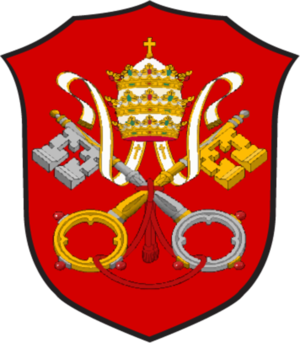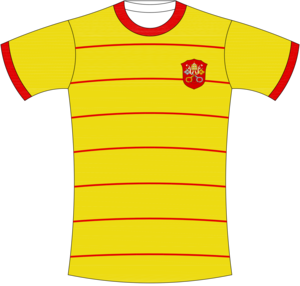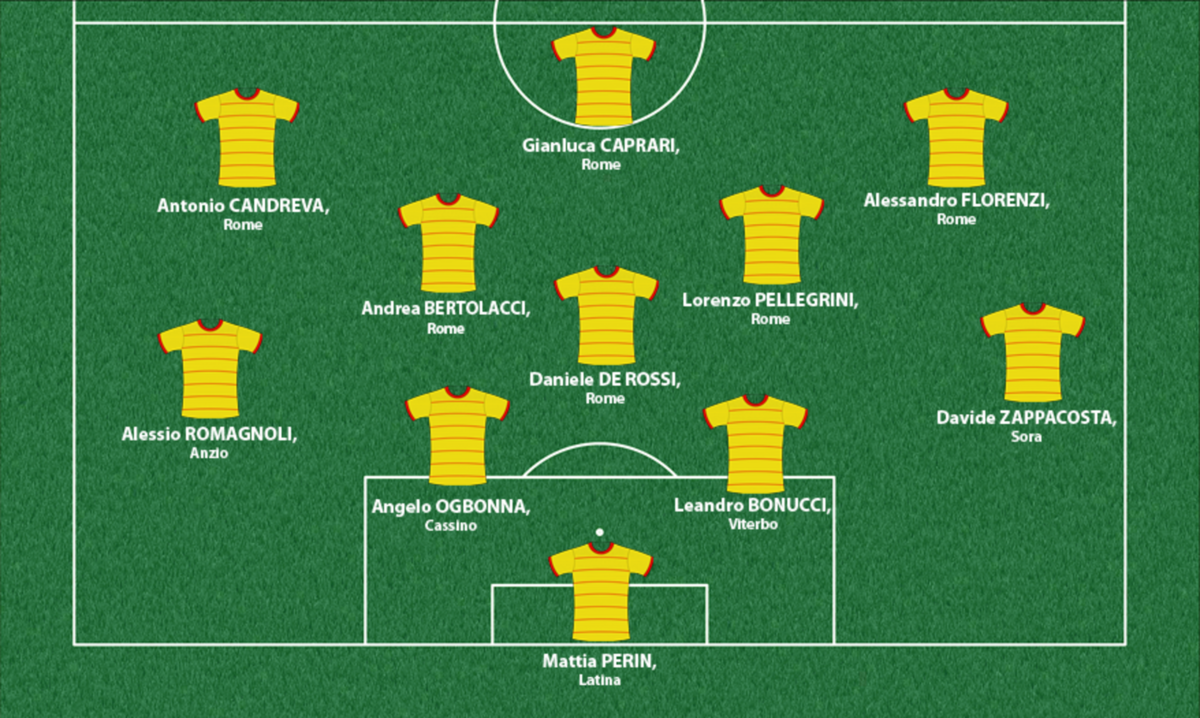The Papal states
The Papal States, officially the State of the Church were territories in the middle of Apennine Peninsula under the sovereign direct rule of the pope.

Coat of arms

Shirt
| Position | First name | Last name | Mjesto rođenja | Like | Dislike | |
|---|---|---|---|---|---|---|
| GK | Mattia | PERIN | Latina |
7 |
0 |
|
| GK | Mirko | PIGLIACELLI | Rome |
1 |
3 |
|
| DC | Angelo | OGBONNA | Cassino |
4 |
2 |
|
| DC | Arturo | CALABRESI | Rome |
1 |
2 |
|
| DC | Kevin | BONIFAZI | Rieti |
1 |
1 |
|
| DC | Leandro | BONUCCI | Viterbo |
12 |
3 |
|
| DRC | Davide | BIRASCHI | Rome |
1 |
1 |
|
| DLC | Alessio | ROMAGNOLI | Anzio |
5 |
1 |
|
| DLC | Emiliano | MORETTI | Rome |
1 |
1 |
|
| DRL | Alessandro | CRESCENZI | Marino |
1 |
2 |
|
| DRL | Lorenzo | DE SILVESTRI | Rome |
3 |
1 |
|
| DR/MR | Davide | ZAPPACOSTA | Sora |
5 |
1 |
|
| DL | Luca | GERMONI | Rome |
0 |
2 |
|
| DMC | Luca | MAZZITELLI | Rome |
0 |
2 |
|
| DMC/DC | Daniele | DE ROSSI | Rome |
11 |
1 |
|
| MC | Alessandro | MURGIA | Rome |
3 |
2 |
|
| MC | Andrea | BERTOLACCI | Rome |
2 |
1 |
|
| MC | Danilo | CATALDI | Rome |
1 |
2 |
|
| MC | Lorenzo | PELLEGRINI | Rome |
6 |
1 |
|
| MC | Valerio | VERRE | Rome |
1 |
2 |
|
| MRC/DR | Alessandro | FLORENZI | Rome |
7 |
1 |
|
| AMRL | Amato | CICIRETTI | Rome |
0 |
2 |
|
| AMRL | Antonio | CANDREVA | Rome |
1 |
3 |
|
| AMRL | Federico | RICCI | Rome |
0 |
2 |
|
| AMRL | Marco | D'ALESSANDRO | Rome |
0 |
2 |
|
| AMRL/SS | Matteo | POLITANO | Rome |
1 |
1 |
|
| FRLC | Alessio | CERCI | Velletri |
3 |
1 |
|
| FRLC | Gianluca | CAPRARI | Rome |
1 |
1 |
|
| FC | Edoardo | SOLERI | Rome |
0 |
2 |
|
| FC | Federico | MACHEDA | Rome |
1 |
1 |
|
| FC | Federico | DIONISI | Rieti |
2 |
1 |
|
| FC | Stefano | NAPOLEONI | Rome |
0 |
2 |
|
| FC/SS | Simone | PALOMBI | Tivoli |
0 |
3 |
(Today part of: central Italy (region Lazio)
The Roman bishop Gregory the Great (590-604) had initiated the Christianization of the barbarous West and the liturgical organization of the Western Church at the beginning of the 7th century, and as a Roman patrician, imbued the rule of the Church with the colonizing and imperialist spirit of the city and the class he belonged to. An even greater estrangement within the Christian Church and its division into the Western and Eastern occurred in the middle of the 8thcentury, when the Roman bishop, during whose term the title “pope” was instituted, started to lean on the military power of the Frankish state, which will result in his political action which was independent of Constantinople. The Frankish general Pepin, who lacked “royal blood,” needed a higher legitimization in his fight against the pretenders to the throne, which he could get solely from the pope. In turn, Pepin showed his gratitude with military campaigns against the Kingdom of the Lombards, whose lands in the central part of the Apennine Peninsula he bequeathed to the pope, by which he will set the foundations for the formation of the Papal State (756).
The relationship between popes and Frankish rulers will take a further step during the time of his successor, Charlemagne (ruled 771 – 814), whom the pope had crowned as the Roman Emperor (800). Thus, Charlemagne had been given a religious excuse for his wars of conquest and the subduing of hostile peoples, and the spiritual authority bestowed upon him by the pope served to strengthen his own authority as the Emperor and the protector of Christendom. On the other hand, with his powerful army and the Emperor at his back, the pope could oppose the Byzantine Emperor and the Patriarch of Constantinople in the issue of the primacy of his Church, and had used Charlemagne’s conquests to Christianize the conquered population. The establishment of a great European Christian state, whose kings, princes, counts, bishops, and monks would follow a single leader – the pope, will remain the aspiration of popes who followed.
Sources
- Michael JORDAN, U ime Božje : nasilje i razaranje u svjetskim religijama, Zagreb 2008.
- Hans KUNG, Katolička crkva – kratka povijest, Zagreb, 2007.
- Jacques LE GOFF, Civilizacija srednjovjekovnog Zapada, Zagreb 1998.
- Roberto LOPEZ, Rođenje Evrope : stoljeća V-XIV, Zagreb, 1978.
- Bože MIMICA, Dalmacija od antike do 1918. : povijesni pregled, Rijeka, 2003.
- Giuliano PROCACCI, Povijest Talijana, Zagreb, 1996.
- ''Papa'', (http://www.enciklopedija.hr/Natuknica.aspx?ID=46500)
- Papal States'', https://www.britannica.com/place/Papal-States
- GRB
- https://en.wikipedia.org/wiki/Coats_of_arms_of_the_Holy_See_and_Vatican_City
